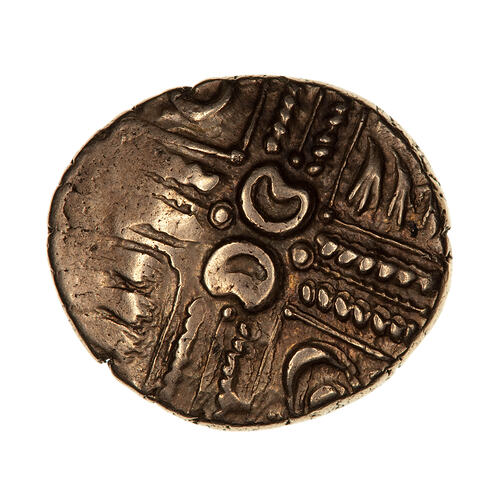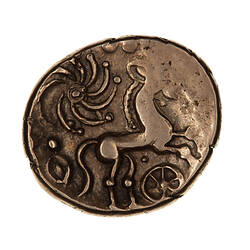Summary
Gold coin; Denomination: Stater
Issued circa 35 BC in the South East of England. This type of stater is known as British M or sometimes Wonersh after a hoard of this type which was discovered at Wonerish in Surrey in 1848. The term British M is from a method of defining issues of Celtic coins used in Britain, they are first referred to by reference to their place of manufacture, 'Gallo-Belgic' coins were struck in what is today France and then carried to Britain and 'British' coins were manufactured and used in Southern England. The letters A, B etc following the issue designator indicate the chronological order of production as determined by archaeological and coin hoard studies, A being earliest, B next and so on to in this case, M. Production is attributed to the Catuvelauni tribe.
Obverse Description
Cruciform ornament made up of four wreaths
Reverse Description
Horse to right; above, large star with 8 curved arms; below, wheel of 6 spokes.
Edge Description
plain
More Information
-
Collecting Areas
-
Acquisition Information
Transfer from National Gallery of Victoria (NGV), 15 Mar 1976
-
Acknowledgement
Purchased, Felton Bequest, 1929
-
Date Issued
circa 35 BC
-
Issued By
Catuvellauni Tribe, Catuvellauni, Ancient Britain, circa 35 BC
-
Denomination
-
Series
-
Material
Gold
-
Axis
11
-
Classification
-
Category
-
Discipline
-
Type of item
-
Overall Dimensions
20 mm (Outside Diameter), 5.425 g (Weight)
17*20 mm
-
Shape
Oval
-
References
[Book] Mack, R. P. 1975. The Coinage of Ancient Britain., p.75 No. 148 Pages
[Book] Evans, John. 1864. The Coins of the Ancient Britons., D.8 Pages
[Book] Skingley, Philip. 2007. Coins of England and the United Kingdom., Spink 36 Pages
-
Keywords


